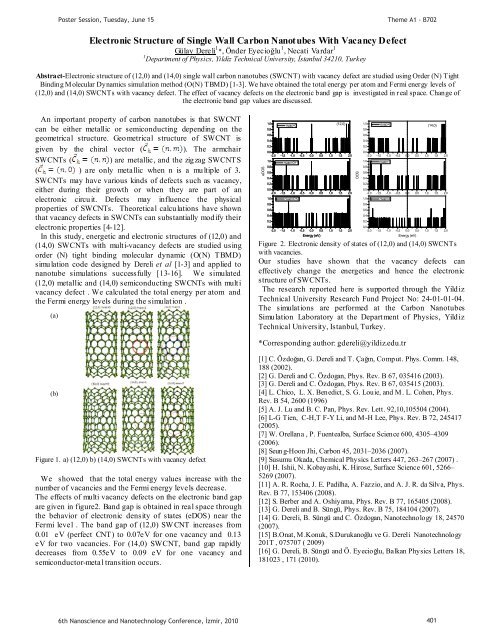Photonic crystals in biology
Photonic crystals in biology
Photonic crystals in biology
You also want an ePaper? Increase the reach of your titles
YUMPU automatically turns print PDFs into web optimized ePapers that Google loves.
Poster Session, Tuesday, June 15<br />
Theme A1 - B702<br />
Electronic Structure of S<strong>in</strong>gle Wall Carbon Nanot ubes With Vacancy Defect<br />
Gülay Dereli 1 *, 1 , Necati Vardar 1<br />
1 Department of Physics, Yildiz Technical University, 34210, Turkey<br />
Abstract-Electronic structure of (12,0) and (14,0) s<strong>in</strong>gle wall carbon nanotubes (SWCNT) with vacancy defect are studied us<strong>in</strong>g Order (N) Tight<br />
B<strong>in</strong>d<strong>in</strong>g Molecular Dynamics simulation method (O(N) TBMD) [1-3]. We have obta<strong>in</strong>ed the total energy per atom and Fermi energy levels of<br />
(12,0) and (14,0) SWCNTs with vacancy defect. The effect of vacancy defects on the electronic band gap is <strong>in</strong>vestigated <strong>in</strong> real space. Change of<br />
the electronic band gap values are discussed.<br />
An important property of carbon nanotubes is that SWCNT<br />
can be either metallic or semiconduct<strong>in</strong>g depend<strong>in</strong>g on the<br />
geometrical structure. Geometrical structure of SWCNT is<br />
given by the chiral vector ( ). The armchair<br />
SWCNTs ( ) are metallic, and the zigzag SWCNTS<br />
( ) are only metallic when n is a mu ltiple of 3.<br />
SWCNTs may have various k<strong>in</strong>ds of defects such as vacancy,<br />
either dur<strong>in</strong>g their growth or when they are part of an<br />
electronic circuit. Defects may <strong>in</strong>fluence the physical<br />
properties of SWCNTs. Theoretical calculations have shown<br />
that vacancy defects <strong>in</strong> SWCNTs can substantially modify their<br />
electronic properties [4-12].<br />
In this study, energetic and electronic structures of (12,0) and<br />
(14,0) SWCNTs with multi-vacancy defects are studied us<strong>in</strong>g<br />
order (N) tight b<strong>in</strong>d<strong>in</strong>g molecular dynamic (O(N) TBMD)<br />
simulation code designed by Dereli et al [1-3] and applied to<br />
nanotube simulations successfully [13-16]. We simulated<br />
(12,0) metallic and (14,0) semiconduct<strong>in</strong>g SWCNTs with multi<br />
vacancy defect . We calculated the total energy per atom and<br />
the Fermi energy levels dur<strong>in</strong>g the simulation .<br />
(a)<br />
eDOS<br />
1,0<br />
nvac=0<br />
(12,0)<br />
0,8<br />
0,6<br />
0,4<br />
0,2<br />
0,0<br />
-2,0 -1,5 -1,0 -0,5 0,0 0,5 1,0 1,5 2,0<br />
1,0<br />
0,8<br />
0,6<br />
0,4<br />
0,2<br />
0,0<br />
-2,0 -1,5 -1,0 -0,5 0,0 0,5 1,0 1,5 2,0<br />
1,0<br />
0,8<br />
0,6<br />
0,4<br />
0,2<br />
nvac=0+1<br />
nvac=0+2<br />
0,0<br />
-2,0 -1,5 -1,0 -0,5 0,0 0,5 1,0 1,5 2,0<br />
Energy (eV)<br />
DOS<br />
1,0<br />
0,8<br />
0,6<br />
0,4<br />
0,2<br />
0,0<br />
-2,0 -1,5 -1,0 -0,5 0,0 0,5 1,0 1,5 2,0<br />
1,0<br />
0,8<br />
0,6<br />
0,4<br />
0,2<br />
0,0<br />
-2,0 -1,5 -1,0 -0,5 0,0 0,5 1,0 1,5 2,0<br />
1,0<br />
0,8<br />
0,6<br />
0,4<br />
0,2<br />
nvac=0 (14,0)<br />
nvac=1<br />
nvac=4<br />
0,0<br />
-2,0 -1,5 -1,0 -0,5 0,0 0,5 1,0 1,5 2,0<br />
Energy (eV)<br />
Figure 2. Electronic density of states of (12,0) and (14,0) SWCNTs<br />
with vacancies.<br />
Our studies have shown that the vacancy defects can<br />
effectively change the energetics and hence the electronic<br />
structure of SWCNTs.<br />
The research reported here is supported through the Yildiz<br />
Technical University Research Fund Project No: 24-01-01-04.<br />
The simulations are performed at the Carbon Nanotubes<br />
Simulation Laboratory at the Department of Physics, Yildiz<br />
Technical University, Istanbul, Turkey.<br />
*Correspond<strong>in</strong>g author: gdereli@yildiz.edu.tr<br />
(b)<br />
Figure 1. a) (12,0) b) (14,0) SWCNTs with vacancy defect<br />
We showed that the total energy values <strong>in</strong>crease with the<br />
number of vacancies and the Fermi energy levels decrease.<br />
The effects of multi vacancy defects on the electronic band gap<br />
are given <strong>in</strong> figure2. Band gap is obta<strong>in</strong>ed <strong>in</strong> real space through<br />
the behavior of electronic density of states (eDOS) near the<br />
Fermi level . The band gap of (12,0) SWCNT <strong>in</strong>creases from<br />
0.01 eV (perfect CNT) to 0.07eV for one vacancy and 0.13<br />
eV for two vacancies. For (14,0) SWCNT, band gap rapidly<br />
decreases from 0.55eV to 0.09 eV for one vacancy and<br />
semiconductor-metal transition occurs.<br />
148,<br />
188 (2002).<br />
[2] G. Dereli and C. Özdogan, Phys. Rev. B 67, 035416 (2003).<br />
[3] G. Dereli and C. Özdogan, Phys. Rev. B 67, 035415 (2003).<br />
[4] L. Chico, L. X. Benedict, S. G. Louie, and M. L. Cohen, Phys.<br />
Rev. B 54, 2600 (1996)<br />
[5] A. J. Lu and B. C. Pan, Phys. Rev. Lett. 92,10,105504 (2004).<br />
[6] L-G Tien, C-H,T F-Y Li, and M-H Lee, Phys. Rev. B 72, 245417<br />
(2005).<br />
[7] W. Orellana , P. Fuentealba, Surface Science 600, 4305–4309<br />
(2006).<br />
[8] Seun g-Hoon Jhi, Carbon 45, 2031–2036 (2007).<br />
[9] Susumu Okada, Chemical Physics Letters 447, 263–267 (2007) .<br />
[10] H. Ishii, N. Kobayashi, K. Hirose, Surface Science 601, 5266–<br />
5269 (2007).<br />
[11] A. R. Rocha, J. E. Padilha, A. Fazzio, and A. J. R. da Silva, Phys.<br />
Rev. B 77, 153406 (2008).<br />
[12] S. Berber and A. Oshiyama, Phys. Rev. B 77, 165405 (2008).<br />
[13] G. Dereli and B. Süngü, Phys. Rev. B 75, 184104 (2007).<br />
[14] G. Dereli, B. Süngü and C. Özdogan, Nanotechnology 18, 24570<br />
(2007).<br />
[15<br />
201T , 075707 ( 2009)<br />
[16<br />
181023 , 171 (2010).<br />
6th Nanoscience and Nanotechnology Conference, zmir, 2010 401













